|

a memoir of the 70s
Nostalgia seems to eventually become the stock in trade
of a fair number of writers. Writers, hell, practically everybody, as
we hit a certain age or level in our vocation (or avocation, in my case).
We begin to yearn for a time when life seemed simpler, when our existence
was uncluttered by the thousand cogs that need to be greased each day
to keep our adult life moving with a semblance of smoothness. This yearning
keeps places like eBay in business. We’re wrong about the simplicity,
of course, it was just that we hadn’t been exposed to a lot of brutal
truths. Ignorance truly was bliss.
Allow me to revisit my ignorance.
1971 was not a spectacular year. It didn’t have the horrifying
social upheaval and assassinations of 68. We were still stuck in Vietnam,
Nixon was still president, and we were yet a couple of years from the
eye-opening morass that was Watergate. Janis, Jimi and Jim were still
alive. Sexually transmitted diseases could still be dealt with via penicillin.
The Smothers Brothers were the epitome of hip. Let me repeat that: The
Smothers Brothers were the epitome of hip. Or so it seemed in South
Texas.
I was thirteen years old, and I would make the weekly
walk to a convenience store near my grandparents’ house. They weren’t
convenience stores then, they were still "drive-in groceries," a holdover
from the Post-War boom where everything suddenly became "drive-in,"
including churches. This particular establishment was called Nunley’s.
Like a lot of these stores at the time - and, looking back, a surprising
number of houses - there was no air conditioning, just large roll-up
doors on two sides of the building to let the wind blow through, and
some electric fans. I also remember the wooden floor having a remarkable
amount of warp for such a dry climate - funny the little details that
stick with you.
Lawn mowing money heavy in my pocket - two dollars, an
amount to conjure with in '71 - I walked the half-mile to Nunley’s.
The sunlight seems uncomfortably bright to my mind’s eye, washing out
the colors of the buildings and trees I pass. There are no sidewalks,
but King Street is wide, and I’m in little danger. Eventually, I pass
the big white building that is the Glass Store and move into the shade
of Nunley’s. Another ten minutes, and I would have been at my other
usual destination, the public library.
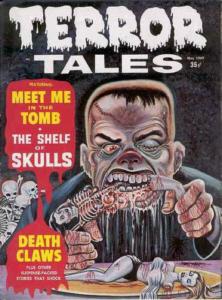 The
reason for the pilgrimage is simple to explain. Nunley’s had a small
magazine rack, and comic books usually didn’t
take up space in it. Though I would gaze curiously at the lurid covers
of the popular men’s magazines of the day (Men’s True Adventure,
for instance, which seemed to imply that WWII was mostly comprised of
Nazis tying up scantily clad women), I was there for the lower part
of the rack, where I would find what I was looking for, half-hidden
behind the crossword puzzle magazines: Creepy, Eerie, Vampirella,
or best of all, Famous Monsters of Filmland. Castle of Frankenstein,
which I would only truly appreciate when I was older. Tales of Voodoo,
Weird and Terror Tales, by Eerie Publications, who claimed
their magazines told tales "in new chilling PICTO-FICTION!" I often
wished these guys had been strangled at an early age, because their
stories exhibited a gleeful amorality drenched in unrepentant gore,
and gave me nightmares the comparatively conservative Warren mags could
never hope to match. (For more on these pervs, check out the groovy Empire of the Claw. And while you're at it, check out The Eerie Publications Cover Archive to find out what you missed by having a normal childhood.) The
reason for the pilgrimage is simple to explain. Nunley’s had a small
magazine rack, and comic books usually didn’t
take up space in it. Though I would gaze curiously at the lurid covers
of the popular men’s magazines of the day (Men’s True Adventure,
for instance, which seemed to imply that WWII was mostly comprised of
Nazis tying up scantily clad women), I was there for the lower part
of the rack, where I would find what I was looking for, half-hidden
behind the crossword puzzle magazines: Creepy, Eerie, Vampirella,
or best of all, Famous Monsters of Filmland. Castle of Frankenstein,
which I would only truly appreciate when I was older. Tales of Voodoo,
Weird and Terror Tales, by Eerie Publications, who claimed
their magazines told tales "in new chilling PICTO-FICTION!" I often
wished these guys had been strangled at an early age, because their
stories exhibited a gleeful amorality drenched in unrepentant gore,
and gave me nightmares the comparatively conservative Warren mags could
never hope to match. (For more on these pervs, check out the groovy Empire of the Claw. And while you're at it, check out The Eerie Publications Cover Archive to find out what you missed by having a normal childhood.)
Even with such a packed playing field, there were weeks
when nothing new was on the stand, and I would turn to the revolving
paperback rack. Thus I read The Poseidon Adventure, probably
about the same time as Irwin Allen. Speaking of strange details stuck
in your mind: one of the female characters has a shipboard affair with
another passenger, and this one sentence sticks in my mind: "like most
short men, he was an excellent lover." Leading me to one of my earliest
recollected insights: Aha. Paul Gallico is short.
Around 70 or so, another player appeared in the apparently
lucrative black-and-white comic magazine market - Skywald Publishing,
which drew its name from the two publishers, Sol Brodsky and Herschel
Waldman. They burst on the scene with a magazine called Psycho,
and soon followed up with another called Nightmare. I recall
issue #1 of Psycho vividly: a screaming man, his body half-reduced
to a skeleton by some unearthly ray. The story was entitled "The Skin
and Bones Syndrome", and beyond the fact that the art was by Gray Morrow,
I don’t recall much else.
The story and art in the Skywald magazines was of a fairly
high quality - comparable, if I recall correctly, with that of the Warren
magazines - so I picked them up whenever I found them. They eventually
put out a sci-fi offering called Science-Fiction Odyssey, which
lasted only an issue or two, and The Crime Machine, a 30’s gangland
magazine which lasted maybe one issue (interesting in light of the failure
of this venture that DC comics tried the same thing a year later with
the black-and-white Jack Kirby experiment In The Days of the Mob).
Then there was that day, the beginning of the summer of
1971, when I was greeted by none of the usual familiar titles of the
magazines I craved, but there was one that was headed "RIGHT
ON - WITH THE NOW SUPER-HERO!"
and thus Hell-Rider came into my life.
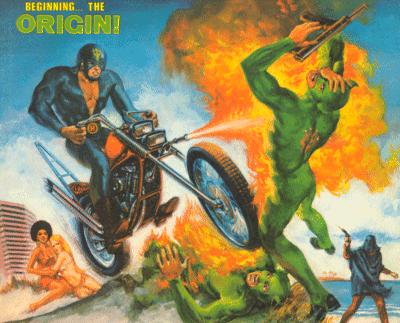 I
quickly ascertained it was indeed a Skywald Publication and a quick
flip through the pages promised super-hero action and, what was more
important, nekkid women. I put down my sixty cents and began the sweaty
walk home. At least, in South Texas, sweat does what it's supposed to:
evaporate and cool you off. Compare that to the sea of humidity I currently
live in, and that walk wasn't so bad. I
quickly ascertained it was indeed a Skywald Publication and a quick
flip through the pages promised super-hero action and, what was more
important, nekkid women. I put down my sixty cents and began the sweaty
walk home. At least, in South Texas, sweat does what it's supposed to:
evaporate and cool you off. Compare that to the sea of humidity I currently
live in, and that walk wasn't so bad.
But back to Hell-Rider, an attempt to create a
modern, mature super-hero. By mature, of course we mean more violence
and the aforementioned nekkid women. A cultural shift toward frustration
was beginning that would eventually birth both Death Wish and
the Executioner series, so Hell-Rider would be doing what other
four-color superheroes couldn't: terminate bad guys with extreme prejudice.
That much you got from the cover which featured the title character
toasting a couple of bad guys with his motorcycle-mounted flame thrower.
With two bikini-clad babes in the background. One blonde, one black,
natch. Right on!
Hell-Rider is Brick Reese (nervously close to Brick Reed,
but hey - ), who is apparently Skywald and writer Gary Friedrich's idea
of a guy with whom we could all identify. As Friedrich states in his
introductory piece, "- we soon decided he would ride a motorcycle, be
a Viet Nam veteran though not necessarily a supporter of the conflict
and come from an upper middle class Eastern background to which he has
become totally alienated." (hey... that's just like me!)
Then after a run-down of his powers and weaknesses (pretty simple, as
you'll see), "The answer, we felt, was simply to make him as TODAY as
possible - he would be a truly human superhero dealing with the human
trials of our era in a no punches-pulled manner. That's why we chose
heroin smuggling as the basis of our first story."
Good thing that, like everyone else in the world, I only
read this text piece after devouring the comic story. Otherwise, I might
have ruined the surprise.
The first story starts out with a two-page splash that
recreates the cover: Hell-Rider's bike smashes through a wall into a
room full of villainous lackeys. We know them to be lackeys because
they are wearing cat suits (so much for super-heroing in the real
world). Right away, HR's intentions are telegraphed by running over
one cat guy and wasting another with that flamethrower. He then proceeds
to throw bad guys right and left, all the while demanding the location
of "The girl!" When two cat men try to outflank him, he responds by
picking up an enormous bookcase "that weighs a TON!!!" and dropping
it on them.
Ah, but then his strength begins to wane, and the cat
men take him down. When he regains consciousness in the obligatory dungeon,
Hell-Rider/Brick embarks on a similarly obligatory voyage of self-examination
and super-hero origin.
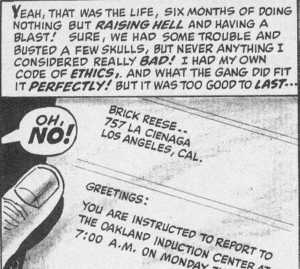 As
Friedrich promised, Reese graduates from law school but refuses to join
his father's law firm. Not wanting to make it "as the boss' son," he
instead heads out to find America. Except he seems to be doing it in
a Corvette, not a motorcycle. One day in an Oakland bar, he finds himself
facing down a motorcycle gang. After tossing the burly head man and
appropriating his knife, Reese reveals he picked up a black belt in
law school. The gang's token black says, "Easy, man! We were only feelin'
you out! Can't have just anybody drinkin' with us, you know!"
And over beer, Reese finds himself joining The Wild Bunch, 'cause the
gang can always use a black belt man, and a lawyer to boot. As
Friedrich promised, Reese graduates from law school but refuses to join
his father's law firm. Not wanting to make it "as the boss' son," he
instead heads out to find America. Except he seems to be doing it in
a Corvette, not a motorcycle. One day in an Oakland bar, he finds himself
facing down a motorcycle gang. After tossing the burly head man and
appropriating his knife, Reese reveals he picked up a black belt in
law school. The gang's token black says, "Easy, man! We were only feelin'
you out! Can't have just anybody drinkin' with us, you know!"
And over beer, Reese finds himself joining The Wild Bunch, 'cause the
gang can always use a black belt man, and a lawyer to boot.
Cue page-long montage of riding, rumbling and rassling
with the fair sex. The Wild Bunch aren't really bad guys, you
see, and as you know, these cycle guys get chicks aplenty (cue first
nekkid woman). All this comes to a halt, however, when Brick gets a
letter from his local draft board. As he tells the Wild Bunch, "I know
I could split for Canada, but then I could never come back - there's
too much here for me! See ya after I win the war!"
As any history book can tell you, Brick Reese did not
win the war. In fact. Three weeks before the end of his tour of duty,
he gets caught in a VC ambush (as do all short-timers), and wakes up
after lying in a coma for seventeen days, assured by the doctor that
he will be able to lead a "nearly normal life".
Reese still has a VC bullet in his skull, and any shock
to his head could instantly kill him. Enter the experimental drug Q-47
(ask for it by name!), and Brick's assertion of, "As they say in the
States, Doc - sock it to me!" (Man, how NOW
can you get?) After a month, daily injections of Q-47 have reduced the
bullet's mass by half, and caused it to completely disappear in another
month. The drug has also enabled Brick to wreck the gym equipment during
his workout.
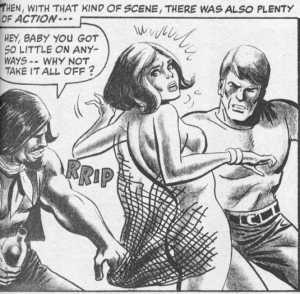 Yep,
Q-47 has made him super strong, which he takes great pains to conceal
(though it is never made clear how he explains away all the destroyed
equipment). Finally, Brick is sent home, to find that he has a job offer
in his uncle's Hollywood law firm and a grandfather who has recently
expired, leaving him a considerable sum of money. Promising his uncle
(whom you know to be sleazy simply by his pencil-thin moustache) that
he'll be by for a job later, Brick proceeds to Take A Vacation by A)
purchasing a Harley, B) purchasing a beach house, C) purchasing "- parties
almost every night! Along with more women than I'd ever known existed!"
(cue nekkid woman #2) Yep,
Q-47 has made him super strong, which he takes great pains to conceal
(though it is never made clear how he explains away all the destroyed
equipment). Finally, Brick is sent home, to find that he has a job offer
in his uncle's Hollywood law firm and a grandfather who has recently
expired, leaving him a considerable sum of money. Promising his uncle
(whom you know to be sleazy simply by his pencil-thin moustache) that
he'll be by for a job later, Brick proceeds to Take A Vacation by A)
purchasing a Harley, B) purchasing a beach house, C) purchasing "- parties
almost every night! Along with more women than I'd ever known existed!"
(cue nekkid woman #2)
But eventually inherited money and nekkid women must come
to an end, and Brick pays a call on his uncle, who sets him up as a
Good-Lookin' Lawyer to the Stars. Enter one of those stars, rock singer
Julie Storm, who is not nekkid, but dang close. Or, as the scantily
clad rock vixen puts it, "In the flesh - almost! But we'll work
on that when I get to know you better!" Impressed by the new
man in the stable, Julie tells Brick, "I'm throwing a bash at my pad
in the canyon tonight! I want you to come!" proving that
James Bond pictures have no monopoly on ham-handed double entendres.
Brick does indeed motor down to the canyon, his narration
informing us that "It was my job to keep a close eye on Julie,
since it had been rumored that she was having problems with drugs."
Arriving, Brick finds that there is a wild wanton early 70's party goin'
on (cue nekkid woman #2a/ topless), but the most illegal thing in evidence
is pot. At least, until Brick spots Julie being unwillingly led away
by a thug in a cat suit.
Following, Brick eavesdrops as Julie is confronted by
a weirdo wearing a black hood and sporting a mechanical claw for a left
hand. If you suspect that this guy is called The Claw, you, too, may
have a future in writing comics. Besides, thugs in cat suits,
the Claw - get it? Get it? Hah?
Anyway, Julie and The Claw seem to have some history,
and the bad guy is after something of Julie's... her 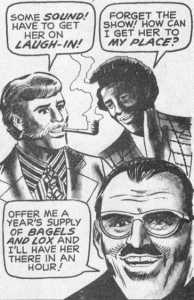 white
go-go boots, which she wears to all her shows. Julie reveals that she
gave the boots to a friend, a singer named Marian Michaels, who just
opened in Vegas and needed a good luck charm. This causes the Claw to
go berserk, erupting that there was a million dollars worth of raw heroin
sewn into the lining of the boots. Not quite The Purloined Letter
as far as MacGuffins go, but not bad. The Claw orders his cat thugs
to take Julie "to the beach" while he goes to Vegas to pick up some
footwear. white
go-go boots, which she wears to all her shows. Julie reveals that she
gave the boots to a friend, a singer named Marian Michaels, who just
opened in Vegas and needed a good luck charm. This causes the Claw to
go berserk, erupting that there was a million dollars worth of raw heroin
sewn into the lining of the boots. Not quite The Purloined Letter
as far as MacGuffins go, but not bad. The Claw orders his cat thugs
to take Julie "to the beach" while he goes to Vegas to pick up some
footwear.
Brick follows the bad guy's limo to an isolated beach
house, all the while not interfering in order to "get some answers".
Peeking in the window, he sees Julie tied to a chair while the cat thugs
prepare to shoot her up with heroin, thus re-establishing The Claw's
hold over her. And it is at this point that yet another cat thug whacks
Brick over the head with a gun butt.
The bewildered Brick wakes up in his own beach house,
surprised that the baddies let him go. Immediately, he swings into action,
thinking, "...I only planned this as a gag at first ...but now
it looks like it just might turn out to be for real!" After confirming
that he has the black leather costume he ordered for his joke, he then
goes down to his garage and starts modifying his Harley. One might wonder
where Brick acquired the know-how to fit a flamethrower and napalm tank
onto a motorcycle (not to mention how to mix up napalm), but I'm more
concerned with where he was hiding the cigarettes he's smoking in the
cell during his flashback.
End of Part One.
In the next story, we meet Marian Michaels, up-and-coming
young black songstress in "the backstage dressing room of the world-famous
Desert Village". She's received a mysterious note warning her to leave
her boots backstage during her show. But figuring that it's "probably
just some nutty soul brother trying for a souvenir!" she wears the boots
onstage anyway. The show is a great success, but when Marian goes back
to her dressing room, who should be waiting for her but Howard Hughes.
Ha ha, I was just making sure you were paying attention. No, it's The
Claw and a couple of his cat thugs, who start making with the threats.
Marian manages to kill the lights and get into "the back room", locking
the door behind her.
 In
the time it takes for the cat thugs to find the door and break it down,
Marian has changed into The Butterfly, a scantily-clad superheroine
who, among other things, has blinding lights built into her cape/wings.
Dazzling the thugs, she splits through a nearby window. The Claw, demonstrating
why he's the head guy, finds the light switch and discovers that Marian
has disappeared - not that this matters, as she left behind the all-important
boots. In
the time it takes for the cat thugs to find the door and break it down,
Marian has changed into The Butterfly, a scantily-clad superheroine
who, among other things, has blinding lights built into her cape/wings.
Dazzling the thugs, she splits through a nearby window. The Claw, demonstrating
why he's the head guy, finds the light switch and discovers that Marian
has disappeared - not that this matters, as she left behind the all-important
boots.
Marian - or, The Butterfly - is actually hanging outside
the window with her suction cup-tipped gloves. Using a rocket pack,
she uses the same gloves to attach herself to the roof of The Claw's
limo. An hour later, The Claw and thugs climb into a helicopter. The
Butterfly follows them until the fuel in her jet pack starts getting
thin, at which point she bursts into the copter, blinds everyone and
steals the boots back again. Her flight back to Vegas is interrupted,
however, by the lack of fuel in her jet pack - looks like her math was
wrong.
So Marian winds up on a desert highway hitching a ride.
And if you had any doubt it was the early 70s, this should set your
mind at rest: "Good thing I folded my paper clothes into the wings -"
Paper clothes. Good Lord, I had forgotten.
Fortunately for Marian, somebody does come along, and
who should it be, but - The Wild Bunch! Who, it turns out, are
old friends of Marian's! It truly is a small comic universe, after all.
Sensing that deep crap is afoot, Marian hands the boots over to the
Bunch to take to her lawyer - who is, naturally, one Brick Reese - while
the Bunch's token female, Ruby, takes the singer back to Vegas.
End of Part Two.

So it must be time for The Wild Bunch's story. First,
the Bunch's individual members are introduced during a typical barroom
brawl. There is the group's leader, Animal, who is the one who took
on Brick in that Oakland Bar (man, it seems like ages ago). You get
the impression that, had Nick Fury been born a couple of decades later,
he'd have become Animal. Then there's Deke, the Bunch's token black.
Slinker, the ski-cap wearing tactician, and by tactician, I mean the
resident dirty fighter. Curly - tall, handsome, muscular, stupid. And
Ruby, mentioned earlier. After all, the Wild Bunch may be outlaws, but
they're good guys, so they needed someone to beat up the women in opposing
gangs.
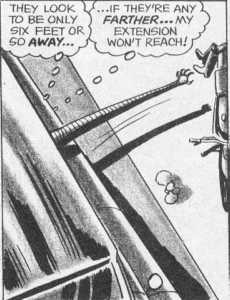 Intros
out of the way, we join the Bunch on their drive to LA. Everyone's lost
in thought – Animal, in particular, is thinking "None of this adds
up somehow -But I guess if Marian says so, we have to take
her word for it! After all, we've been uptight with her for years
now! No reason to think she'd send us on a bummer!" Um, yeah.
Like, wow, man. Intros
out of the way, we join the Bunch on their drive to LA. Everyone's lost
in thought – Animal, in particular, is thinking "None of this adds
up somehow -But I guess if Marian says so, we have to take
her word for it! After all, we've been uptight with her for years
now! No reason to think she'd send us on a bummer!" Um, yeah.
Like, wow, man.
Nonetheless, the Wild Bunch pull over to have a confab
about their strange errand, which makes them a stationary target as
a limo drives by. And speaking of how small this comic universe is,
I supposes you can guess who's in the limo. Yessiree, the limo in question
starts belching out cat thugs like a clown car, since The Claw saw the
boots draped over the back of one of the cycles.
While the Bunch is involved in kicking cat-man ass, The
Claw manages to steal the boots by using a six foot extension of his
claw (probably thinking about how everybody laughed at him when he paid
for the upgrade). After making sure the last of the Cat Men lose their
teeth, the Bunch pursues, eventually using the old chain-through-the-windshield
trick to make the limo crack up. But The Claw has radioed to "Commune
One" for reinforcements, and The Wild Bunch wind up trapped in nets
dropped from helicopters. Except of course, for resident sneak Slinker,
who takes off with the boots, and rather improbably causes a pursuing
helicopter to crash into a cliff.
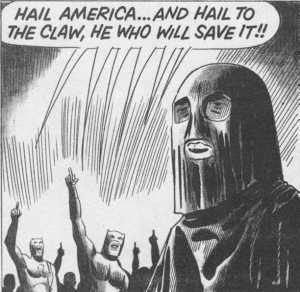 The
rest of the crew are taken to Commune One, where they are tied to stakes
while the Claw addresses his legion of cat men (and a couple of hippie
chicks): "These, fellow members of the Commune, are the very vermin
which are eating out the heart of our country - and it is they and thousands
like them who must be destroyed - if America is to remain the home
of the free!" Followed by the legions saluting him and shouting
"HAIL AMERICA - AND HAIL TO THE CLAW, HE WHO WILL SAVE IT!!!" The
rest of the crew are taken to Commune One, where they are tied to stakes
while the Claw addresses his legion of cat men (and a couple of hippie
chicks): "These, fellow members of the Commune, are the very vermin
which are eating out the heart of our country - and it is they and thousands
like them who must be destroyed - if America is to remain the home
of the free!" Followed by the legions saluting him and shouting
"HAIL AMERICA - AND HAIL TO THE CLAW, HE WHO WILL SAVE IT!!!"
Sharp-eyed comic readers will note that the salute given
to the Claw involves an extended middle finger.
End Part Three.
Meanwhile, back at the Hell-Rider -
Brick exposits that's been over 24 hours, so if his strength
is ever going to come back, it's going to be now. By way of demonstration,
he yanks the bars out of the window, puts his helmet back on, and rescues
Julie, who's been overdosed (yeah, kill her with heroin, that's the
way to reassert your hold over her. Henchmen can be so incompetent...)
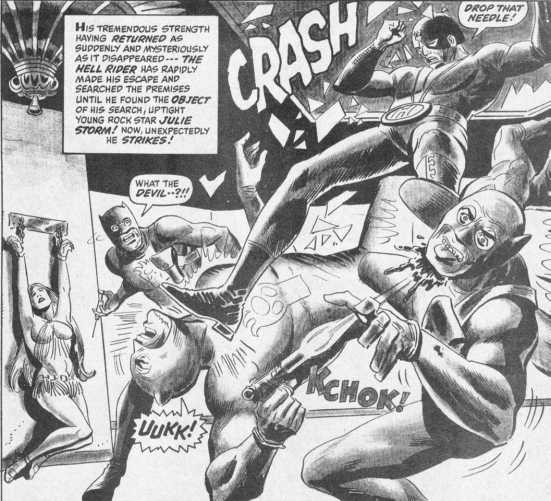 Hell-Rider
immediately drops Julie off at a hospital emergency room, then zooms
off fight ee-vil without answering questions, ensuring that the doctors
will tell the cops that Julie's condition is his fault - so Hell-Rider
will now be on the run from The Man! What a hassle! Hell-Rider
immediately drops Julie off at a hospital emergency room, then zooms
off fight ee-vil without answering questions, ensuring that the doctors
will tell the cops that Julie's condition is his fault - so Hell-Rider
will now be on the run from The Man! What a hassle!
Returning to his secret lair at his beach house, Brick
gets a phone call from Marian - Slinker has shown up with the boots
at her Vegas pad, and Ruby (more than a pretty face) has discovered
the heroin in the boots' lining. (After sniffing it. What class do you
go to in Cycle Gang School that gives you this ability?) Brick tells
them to stay put, he's on his way - and he has enough sense to change
into Brick Reese clothes so he can get past any police roadblocks. Not
that they'd notice the nozzle of the flamethrower sticking out the front
of the Harley, or anything...
Meanwhile, The Claw is having problems with his troops,
who are getting restless because The Claw keeps losing their grubstake.
Although it is hard to take anyone wearing a cat suit seriously, the
thugs inform the Claw that he has 24 hours to get the funding back on
line, or they'll... go get jobs at a McDonald's, or something. The Wild
Bunch, meanwhile, have been working on their bonds, and Curly manages
to get loose by scraping off most of the meat on his wrists. Freeing
the others, they make it to their bikes and escape by making an Evel
Knieval leap over a canyon.
The Claw shows up at Marian's pad and threatens Marian,
Ruby and Slinker for the heroin. They manage to stall him long enough
for Brick to arrive, change into Hell-Rider and use rocket packs he
fitted on his bike to drive up the side of the hotel and into Marian's
apartment, running over The Claw. Good thing the situation was so
dangerous in there, with the Claw preparing to kill the three - I mean,
you don't want to go driving up the side of a building and crashing
through a plate glass window, just to find out that everybody was playing
Yahtzee. The Claw is unmasked, revealing him to be ...Brick's uncle!
I told you his moustache was up to no good!
And, though not pointed up - one point for the writing
- of course the bad guys had to let him go back in Chapter One.
Our whole cast gets together for the last panel, congratulating
themselves for stopping "...a bunch of loonies who could've put this
country into a civil war!" There is the problem of the law looking for
Hell-Rider, but then, they were looking for Billy Jack, too. The end.
It was an interesting debut. The single story arc involving
all the characters was fairly novel, and there was enough that was new
in the approach to make me look forward for the next issue.
By the time that issue came out, though - the second and
last one - the holes were beginning to show. The header was changed
to, " Right On with the Cycling Superhero!", perhaps in an effort
to broaden the market appeal to the readers of more motor-oriented publications
like CARtoons and CycleToons. The over-riding story arc
was abandoned in favor of individual stories, robbing the series of
any novelty it could previously claim.
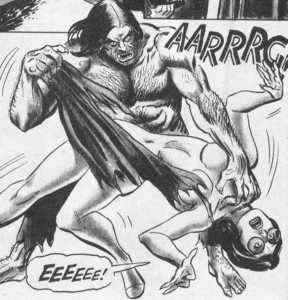 In
the first Hell-Rider story, "Night of the Ripper", HR is trying to track
down The Ripper (duh!), a bestial man-thing who likes to pull off women's
clothing while he tears out their throats. He seems to be concentrating
on the hostesses at The Nightowl Club (a transparent allusion to the
Playboy Club and its bunnies), and the main suspect is the owner of
the Clubs, Selwyn Samuels, who is a chemist in his spare time working
on "the greatest discovery of the century!" He's interested in Brick
for his use of the now-discontinued Q-47, and Reese is certain Samuels'
experiments have resulted in a Jekyll-Hyde scenario. After the Ripper
nearly pulls out Hell-Rider's throat, Brick will eventually resort to
a handgun to put the rampaging monster down, leading to a twist ending
that is incredibly expected. In
the first Hell-Rider story, "Night of the Ripper", HR is trying to track
down The Ripper (duh!), a bestial man-thing who likes to pull off women's
clothing while he tears out their throats. He seems to be concentrating
on the hostesses at The Nightowl Club (a transparent allusion to the
Playboy Club and its bunnies), and the main suspect is the owner of
the Clubs, Selwyn Samuels, who is a chemist in his spare time working
on "the greatest discovery of the century!" He's interested in Brick
for his use of the now-discontinued Q-47, and Reese is certain Samuels'
experiments have resulted in a Jekyll-Hyde scenario. After the Ripper
nearly pulls out Hell-Rider's throat, Brick will eventually resort to
a handgun to put the rampaging monster down, leading to a twist ending
that is incredibly expected.
In "Blood On Their Spokes", the Wild Bunch is beating
up on a rival gang who is attempting to highjack a blood shipment bound
for an "orphan's hospital" ...gee, these really are good guys,
you know? The story also introduces Ted Lawson, a police detective who
would feed the Bunch info on such skullduggery so they could take care
of things in a way the law could not. To be sure, lots of rival bikers
wind up bleeding on the pavement and the gangster's limo is once again
on the receiving end of a chain, causing a fatal crack-up. Though we
are never told exactly what gangsters would do with a shipment of blood.
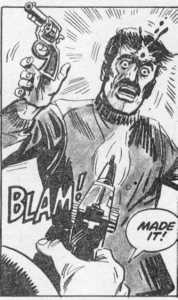 The
Butterfly story, "Against The Brothers of The Crimson Cross", once again
pits one of our heroes against a group of fashion-challenged fascist
nuts, with a hooded head man whose identity surprises no one. It's only
in the final Hell-Rider story "Shanghai - 70s Style" that the proceedings
rise to the level of the first issue's story, as Brick accidentally
stumbles onto a mob that's forcing kidnapped Mexican laborers to work
on a hidden marijuana farm. HR's strength cuts out on him early in the
story, and he's forced to take on the bad guys as a mere mortal - once
again, relying on a gun in the final battle. At least, in the last panel
of this last issue, Brick is finally about to get laid, thinking, "
I knew all along there had to be some reward to this super-heroing
business!" As far as last lines go, it's not "Forget it Jake - it's
Chinatown," or "It's the stuff that dreams are made of," but it'll do.
And it's about as early 70s as you can get. The
Butterfly story, "Against The Brothers of The Crimson Cross", once again
pits one of our heroes against a group of fashion-challenged fascist
nuts, with a hooded head man whose identity surprises no one. It's only
in the final Hell-Rider story "Shanghai - 70s Style" that the proceedings
rise to the level of the first issue's story, as Brick accidentally
stumbles onto a mob that's forcing kidnapped Mexican laborers to work
on a hidden marijuana farm. HR's strength cuts out on him early in the
story, and he's forced to take on the bad guys as a mere mortal - once
again, relying on a gun in the final battle. At least, in the last panel
of this last issue, Brick is finally about to get laid, thinking, "
I knew all along there had to be some reward to this super-heroing
business!" As far as last lines go, it's not "Forget it Jake - it's
Chinatown," or "It's the stuff that dreams are made of," but it'll do.
And it's about as early 70s as you can get.
In retrospect, Hell-Rider was a failed experiment,
mainly because it was neither fish nor fowl - though it wanted to be
a fresh take on the superhero genre, it was also too-firmly rooted in
that genre's conventions to really claim that freshness. All it had
going for it was increased violence, some nods toward sexuality, and
an ability to have characters say "Hell" and "Damn" whenever they wanted.
The writing, though neither worse nor better than that
found in other contemporary comics, is too peppered with "with-it" slang
- most of this stuff couldn't even be taken seriously in 1971. In an
attempt to tease us along, the Butterfly's origin was never explained,
so to this day we can only speculate how a hip young songstress came
to have a costume that enabled her to fly, stick to walls, and blind
thugs so they'd accidentally walk out helicopter doors.
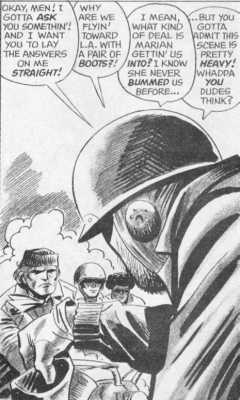 It
was apparently requisite that at least one nekkid woman should appear
in each story. Except for the Butterfly stories, being (I suppose) the
feminist stories of the mag. Then again, The Butterfly apparently shopped
at the same store as Vampirella, so plenty of skin was still on display.
And though I make reference to nudity here, I should point out that
this is early 70s comic nudity, with which any reader of (again) Vampirella
will already be familiar. Artistic representations of the bottom are
okay - everybody has a bottom - as are breasts, but nipples are not
allowed. And forget the pubic region. Still, this was good enough
for the pre-teen me, though the combination of nudity and death that
is rampant in "Night of the Ripper" still makes me queasy, and
I wonder if Friedrich saw Night of the Bloody Apes that week,
or something. It
was apparently requisite that at least one nekkid woman should appear
in each story. Except for the Butterfly stories, being (I suppose) the
feminist stories of the mag. Then again, The Butterfly apparently shopped
at the same store as Vampirella, so plenty of skin was still on display.
And though I make reference to nudity here, I should point out that
this is early 70s comic nudity, with which any reader of (again) Vampirella
will already be familiar. Artistic representations of the bottom are
okay - everybody has a bottom - as are breasts, but nipples are not
allowed. And forget the pubic region. Still, this was good enough
for the pre-teen me, though the combination of nudity and death that
is rampant in "Night of the Ripper" still makes me queasy, and
I wonder if Friedrich saw Night of the Bloody Apes that week,
or something.
Most of the art chores were handled by the team of Ross
Andru and Mike Esposito, who had long, stellar careers in the comic
field. Off the top of my head I can name Metal Men, Wonder Woman
and Spider-Man as comics that benefited from their talents. They
had the knack of drawing the late 60s early 70s ideal of a beautiful
woman, and this was put to good use in this short-lived series. Syd
Shores was brought in as a Penciller on "Blood on Their Spokes" and
Rich Buckler drew and plotted the rather lame second Butterfly story.
The second issue is overall weak enough to make one despair
about what course the series might have taken had it continued, but
it's always rough going in the early part of any series. The
best parts involved social issues Friedrich apparently cared about,
and if they had stayed the course on those - and maybe returned to the
connecting story arc - the series would have had a shot at establishing
its own identity. This aching need to be relevant is what marks Hell-Rider
as a child of the 70s even more surely than the female flesh on display.
As it is, the inclusion of more comic-bookish bizarrely-costumed
adversaries - and the intrusion of a downright supernatural one in the
case of the Ripper - seems terribly at odds with the desire to do a
"superhero in the real world" book. And when more down-to-earth criminal
types, like the mobster Bomar in "Blood on Their Spokes" and the unnamed
Head Guy in "Shanghai" are involved, they are given no character at
all. We see Bomar's face once, just before his fatal wreck, and we only
see the Head Guy's car before he similarly Exits Stage Left (due to
an oil slick HR sprays on the road - another gimmick we didn't know
his bike possessed). Heroes are judged by their opponents as much as
anything, and sending the main characters up against easily-bested unknowns
does not speak well of them. It's probably more realistic, but paradoxically,
that weakens the story.
As I mentioned, Hell-Rider lasted only two issues.
Though I waited rather non-committally for a third issue, it never came,
and I didn't really miss it - there were always other mags on which
to waste my lawn-mowing money. Hell-Rider joined the growing list of
failed super-heroes in my memory banks that included Super
President, Jack Q-Frost and Green Globule (about whom the less said,
the better).
I've visited the old home town several times in the past
decade, usually to place flowers on relative's graves, not the least
of which is those of my grandparents, who so kindly indulged my weirdness
all those years. The town seems sunburned and brittle these days. A
once thriving shipping industry based on railways had long since been
supplanted by trucking, diverting the town's life-blood elswhere. The
train station still stood, though boarded up and abandoned for years.
A mall, just opened the year my family moved away, which was pulling
business away from the downtown district, was all but deserted, my footfalls
echoing in the empty halls. It was damned spooky. The Rialto theater
was also sealed and desolate, seeming far smaller than the heroic edifice
I remembered.
In my darker moments, I contemplate this as a metaphor
for my life: vibrant and optimistic beginnings worn away over time by
happenstance and decay to a sort of mere subsistence. Then I sober up
and realize that my childhood was exactly that: my childhood, the earliest
part of my life, and only the first step on a long journey which still
continues, separate from the place of my birth. It's only a small part
of what made me as I am today, and though I miss that youth - and there
are parts of the 70s I will always miss, the curse of being human
and having a memory - it's over, long gone, and I don't have Dick Nixon
to kick around anymore.
And whatever else, I'll never have to worry about seeing
a Hell-Rider movie. That's some comfort.
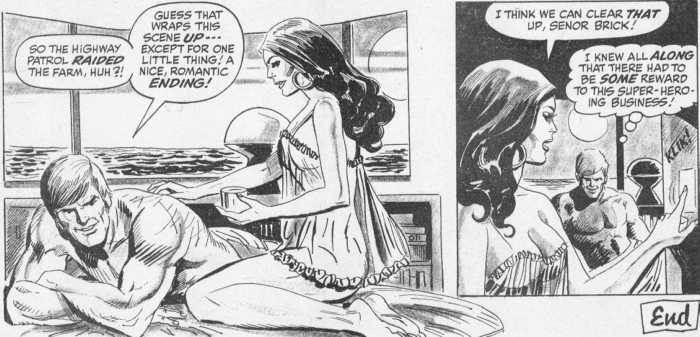
|

 The
reason for the pilgrimage is simple to explain. Nunley’s had a small
magazine rack, and comic books usually didn’t
take up space in it. Though I would gaze curiously at the lurid covers
of the popular men’s magazines of the day (Men’s True Adventure,
for instance, which seemed to imply that WWII was mostly comprised of
Nazis tying up scantily clad women), I was there for the lower part
of the rack, where I would find what I was looking for, half-hidden
behind the crossword puzzle magazines: Creepy, Eerie, Vampirella,
or best of all, Famous Monsters of Filmland. Castle of Frankenstein,
which I would only truly appreciate when I was older. Tales of Voodoo,
Weird and Terror Tales, by Eerie Publications, who claimed
their magazines told tales "in new chilling PICTO-FICTION!" I often
wished these guys had been strangled at an early age, because their
stories exhibited a gleeful amorality drenched in unrepentant gore,
and gave me nightmares the comparatively conservative Warren mags could
never hope to match. (For more on these pervs, check out the groovy
The
reason for the pilgrimage is simple to explain. Nunley’s had a small
magazine rack, and comic books usually didn’t
take up space in it. Though I would gaze curiously at the lurid covers
of the popular men’s magazines of the day (Men’s True Adventure,
for instance, which seemed to imply that WWII was mostly comprised of
Nazis tying up scantily clad women), I was there for the lower part
of the rack, where I would find what I was looking for, half-hidden
behind the crossword puzzle magazines: Creepy, Eerie, Vampirella,
or best of all, Famous Monsters of Filmland. Castle of Frankenstein,
which I would only truly appreciate when I was older. Tales of Voodoo,
Weird and Terror Tales, by Eerie Publications, who claimed
their magazines told tales "in new chilling PICTO-FICTION!" I often
wished these guys had been strangled at an early age, because their
stories exhibited a gleeful amorality drenched in unrepentant gore,
and gave me nightmares the comparatively conservative Warren mags could
never hope to match. (For more on these pervs, check out the groovy  I
quickly ascertained it was indeed a Skywald Publication and a quick
flip through the pages promised super-hero action and, what was more
important, nekkid women. I put down my sixty cents and began the sweaty
walk home. At least, in South Texas, sweat does what it's supposed to:
evaporate and cool you off. Compare that to the sea of humidity I currently
live in, and that walk wasn't so bad.
I
quickly ascertained it was indeed a Skywald Publication and a quick
flip through the pages promised super-hero action and, what was more
important, nekkid women. I put down my sixty cents and began the sweaty
walk home. At least, in South Texas, sweat does what it's supposed to:
evaporate and cool you off. Compare that to the sea of humidity I currently
live in, and that walk wasn't so bad.  As
Friedrich promised, Reese graduates from law school but refuses to join
his father's law firm. Not wanting to make it "as the boss' son," he
instead heads out to find America. Except he seems to be doing it in
a Corvette, not a motorcycle. One day in an Oakland bar, he finds himself
facing down a motorcycle gang. After tossing the burly head man and
appropriating his knife, Reese reveals he picked up a black belt in
law school. The gang's token black says, "Easy, man! We were only feelin'
you out! Can't have just anybody drinkin' with us, you know!"
And over beer, Reese finds himself joining The Wild Bunch, 'cause the
gang can always use a black belt man, and a lawyer to boot.
As
Friedrich promised, Reese graduates from law school but refuses to join
his father's law firm. Not wanting to make it "as the boss' son," he
instead heads out to find America. Except he seems to be doing it in
a Corvette, not a motorcycle. One day in an Oakland bar, he finds himself
facing down a motorcycle gang. After tossing the burly head man and
appropriating his knife, Reese reveals he picked up a black belt in
law school. The gang's token black says, "Easy, man! We were only feelin'
you out! Can't have just anybody drinkin' with us, you know!"
And over beer, Reese finds himself joining The Wild Bunch, 'cause the
gang can always use a black belt man, and a lawyer to boot. Yep,
Q-47 has made him super strong, which he takes great pains to conceal
(though it is never made clear how he explains away all the destroyed
equipment). Finally, Brick is sent home, to find that he has a job offer
in his uncle's Hollywood law firm and a grandfather who has recently
expired, leaving him a considerable sum of money. Promising his uncle
(whom you know to be sleazy simply by his pencil-thin moustache) that
he'll be by for a job later, Brick proceeds to Take A Vacation by A)
purchasing a Harley, B) purchasing a beach house, C) purchasing "- parties
almost every night! Along with more women than I'd ever known existed!"
(cue nekkid woman #2)
Yep,
Q-47 has made him super strong, which he takes great pains to conceal
(though it is never made clear how he explains away all the destroyed
equipment). Finally, Brick is sent home, to find that he has a job offer
in his uncle's Hollywood law firm and a grandfather who has recently
expired, leaving him a considerable sum of money. Promising his uncle
(whom you know to be sleazy simply by his pencil-thin moustache) that
he'll be by for a job later, Brick proceeds to Take A Vacation by A)
purchasing a Harley, B) purchasing a beach house, C) purchasing "- parties
almost every night! Along with more women than I'd ever known existed!"
(cue nekkid woman #2) white
go-go boots, which she wears to all her shows. Julie reveals that she
gave the boots to a friend, a singer named Marian Michaels, who just
opened in Vegas and needed a good luck charm. This causes the Claw to
go berserk, erupting that there was a million dollars worth of raw heroin
sewn into the lining of the boots. Not quite The Purloined Letter
as far as MacGuffins go, but not bad. The Claw orders his cat thugs
to take Julie "to the beach" while he goes to Vegas to pick up some
footwear.
white
go-go boots, which she wears to all her shows. Julie reveals that she
gave the boots to a friend, a singer named Marian Michaels, who just
opened in Vegas and needed a good luck charm. This causes the Claw to
go berserk, erupting that there was a million dollars worth of raw heroin
sewn into the lining of the boots. Not quite The Purloined Letter
as far as MacGuffins go, but not bad. The Claw orders his cat thugs
to take Julie "to the beach" while he goes to Vegas to pick up some
footwear. In
the time it takes for the cat thugs to find the door and break it down,
Marian has changed into The Butterfly, a scantily-clad superheroine
who, among other things, has blinding lights built into her cape/wings.
Dazzling the thugs, she splits through a nearby window. The Claw, demonstrating
why he's the head guy, finds the light switch and discovers that Marian
has disappeared - not that this matters, as she left behind the all-important
boots.
In
the time it takes for the cat thugs to find the door and break it down,
Marian has changed into The Butterfly, a scantily-clad superheroine
who, among other things, has blinding lights built into her cape/wings.
Dazzling the thugs, she splits through a nearby window. The Claw, demonstrating
why he's the head guy, finds the light switch and discovers that Marian
has disappeared - not that this matters, as she left behind the all-important
boots.
 Intros
out of the way, we join the Bunch on their drive to LA. Everyone's lost
in thought – Animal, in particular, is thinking "None of this adds
up somehow -But I guess if Marian says so, we have to take
her word for it! After all, we've been uptight with her for years
now! No reason to think she'd send us on a bummer!" Um, yeah.
Like, wow, man.
Intros
out of the way, we join the Bunch on their drive to LA. Everyone's lost
in thought – Animal, in particular, is thinking "None of this adds
up somehow -But I guess if Marian says so, we have to take
her word for it! After all, we've been uptight with her for years
now! No reason to think she'd send us on a bummer!" Um, yeah.
Like, wow, man. The
rest of the crew are taken to Commune One, where they are tied to stakes
while the Claw addresses his legion of cat men (and a couple of hippie
chicks): "These, fellow members of the Commune, are the very vermin
which are eating out the heart of our country - and it is they and thousands
like them who must be destroyed - if America is to remain the home
of the free!" Followed by the legions saluting him and shouting
"HAIL AMERICA - AND HAIL TO THE CLAW, HE WHO WILL SAVE IT!!!"
The
rest of the crew are taken to Commune One, where they are tied to stakes
while the Claw addresses his legion of cat men (and a couple of hippie
chicks): "These, fellow members of the Commune, are the very vermin
which are eating out the heart of our country - and it is they and thousands
like them who must be destroyed - if America is to remain the home
of the free!" Followed by the legions saluting him and shouting
"HAIL AMERICA - AND HAIL TO THE CLAW, HE WHO WILL SAVE IT!!!" Hell-Rider
immediately drops Julie off at a hospital emergency room, then zooms
off fight ee-vil without answering questions, ensuring that the doctors
will tell the cops that Julie's condition is his fault - so Hell-Rider
will now be on the run from The Man! What a hassle!
Hell-Rider
immediately drops Julie off at a hospital emergency room, then zooms
off fight ee-vil without answering questions, ensuring that the doctors
will tell the cops that Julie's condition is his fault - so Hell-Rider
will now be on the run from The Man! What a hassle! In
the first Hell-Rider story, "Night of the Ripper", HR is trying to track
down The Ripper (duh!), a bestial man-thing who likes to pull off women's
clothing while he tears out their throats. He seems to be concentrating
on the hostesses at The Nightowl Club (a transparent allusion to the
Playboy Club and its bunnies), and the main suspect is the owner of
the Clubs, Selwyn Samuels, who is a chemist in his spare time working
on "the greatest discovery of the century!" He's interested in Brick
for his use of the now-discontinued Q-47, and Reese is certain Samuels'
experiments have resulted in a Jekyll-Hyde scenario. After the Ripper
nearly pulls out Hell-Rider's throat, Brick will eventually resort to
a handgun to put the rampaging monster down, leading to a twist ending
that is incredibly expected.
In
the first Hell-Rider story, "Night of the Ripper", HR is trying to track
down The Ripper (duh!), a bestial man-thing who likes to pull off women's
clothing while he tears out their throats. He seems to be concentrating
on the hostesses at The Nightowl Club (a transparent allusion to the
Playboy Club and its bunnies), and the main suspect is the owner of
the Clubs, Selwyn Samuels, who is a chemist in his spare time working
on "the greatest discovery of the century!" He's interested in Brick
for his use of the now-discontinued Q-47, and Reese is certain Samuels'
experiments have resulted in a Jekyll-Hyde scenario. After the Ripper
nearly pulls out Hell-Rider's throat, Brick will eventually resort to
a handgun to put the rampaging monster down, leading to a twist ending
that is incredibly expected. The
Butterfly story, "Against The Brothers of The Crimson Cross", once again
pits one of our heroes against a group of fashion-challenged fascist
nuts, with a hooded head man whose identity surprises no one. It's only
in the final Hell-Rider story "Shanghai - 70s Style" that the proceedings
rise to the level of the first issue's story, as Brick accidentally
stumbles onto a mob that's forcing kidnapped Mexican laborers to work
on a hidden marijuana farm. HR's strength cuts out on him early in the
story, and he's forced to take on the bad guys as a mere mortal - once
again, relying on a gun in the final battle. At least, in the last panel
of this last issue, Brick is finally about to get laid, thinking, "
I knew all along there had to be some reward to this super-heroing
business!" As far as last lines go, it's not "Forget it Jake - it's
Chinatown," or "It's the stuff that dreams are made of," but it'll do.
And it's about as early 70s as you can get.
The
Butterfly story, "Against The Brothers of The Crimson Cross", once again
pits one of our heroes against a group of fashion-challenged fascist
nuts, with a hooded head man whose identity surprises no one. It's only
in the final Hell-Rider story "Shanghai - 70s Style" that the proceedings
rise to the level of the first issue's story, as Brick accidentally
stumbles onto a mob that's forcing kidnapped Mexican laborers to work
on a hidden marijuana farm. HR's strength cuts out on him early in the
story, and he's forced to take on the bad guys as a mere mortal - once
again, relying on a gun in the final battle. At least, in the last panel
of this last issue, Brick is finally about to get laid, thinking, "
I knew all along there had to be some reward to this super-heroing
business!" As far as last lines go, it's not "Forget it Jake - it's
Chinatown," or "It's the stuff that dreams are made of," but it'll do.
And it's about as early 70s as you can get. It
was apparently requisite that at least one nekkid woman should appear
in each story. Except for the Butterfly stories, being (I suppose) the
feminist stories of the mag. Then again, The Butterfly apparently shopped
at the same store as Vampirella, so plenty of skin was still on display.
And though I make reference to nudity here, I should point out that
this is early 70s comic nudity, with which any reader of (again) Vampirella
will already be familiar. Artistic representations of the bottom are
okay - everybody has a bottom - as are breasts, but nipples are not
allowed. And forget the pubic region. Still, this was good enough
for the pre-teen me, though the combination of nudity and death that
is rampant in "Night of the Ripper" still makes me queasy, and
I wonder if Friedrich saw Night of the Bloody Apes that week,
or something.
It
was apparently requisite that at least one nekkid woman should appear
in each story. Except for the Butterfly stories, being (I suppose) the
feminist stories of the mag. Then again, The Butterfly apparently shopped
at the same store as Vampirella, so plenty of skin was still on display.
And though I make reference to nudity here, I should point out that
this is early 70s comic nudity, with which any reader of (again) Vampirella
will already be familiar. Artistic representations of the bottom are
okay - everybody has a bottom - as are breasts, but nipples are not
allowed. And forget the pubic region. Still, this was good enough
for the pre-teen me, though the combination of nudity and death that
is rampant in "Night of the Ripper" still makes me queasy, and
I wonder if Friedrich saw Night of the Bloody Apes that week,
or something.